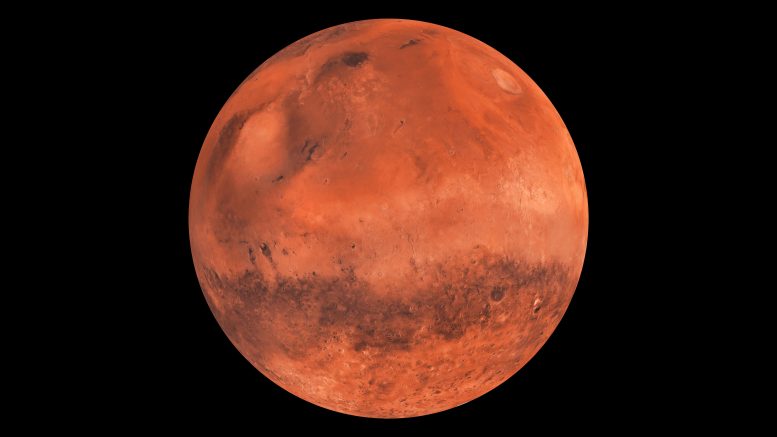Though to most, Mars is only synonymous with a dull red point in the sky, it has still managed to capture the imagination of humanity for millennia, inspiring everything from best-selling sci-fi series to ancient Greek gods. This past month, the scientific community has taken a revolutionary step toward understanding the Red Planet with the successful landing of the NASA rover Perseverance. For the next 687 days – a single Mars year – it will roam the rocky deserts, expansive plains, and craters of our mysterious neighbor, collecting rock samples and, hopefully, discover signs of past life in the barren landscape.
Humanity’s Fascination with the Red Planet
Though we’ve seen a reemergence of the ‘Mars mania’ over the last few decades, this phenomenon is nothing new. In fact, there are records of the Red Planet going as far back as ancient Egypt, almost 4000 years ago, on the ceiling of pharaohs’ tombs. In many cultures, it came to be synonymous with different gods or omens. The planet’s rusty red color was often equated with destruction: in Greece, Mars was tied to the Ares, the god of war, and in Babylon, it represented Nergal, the god of fire and carnage. By the 1800s, our obsession with Mars was far from over; as the telescope’s popularity grew, so did the Red Planet’s. Soon maps of Mars, drawn by astronomers and cartographers alike, began circulating among the public, detailing ice caps, canyons, and terrain almost similar to Earth’s. The most prominent of these was Giovanni Schiaparelli’s work. This Victorian-era Italian scholar drew an incredibly sophisticated diagram featuring volcanos, islands, and, most importantly, long and winding canals. These decidedly engineered canals inspired the question that still prods scientists’ brains today: Is there life on Mars? To them, ‘life’ was Martians battling a climate crisis with a planet-wide irrigation network; to us, ‘life’ refers to microscopic fossils of bacteria possibly buried in the treacherous (decidedly canal-free) landscape.
After man’s first step on the moon in 1969, the public’s curiosity of the final frontier only grew. Similar to the ‘Space Race’ for the moon, Soviet and US scientists scrambled to reach Mars by any means possible. Though the Soviet Union launched nine probes and two flybys, they all failed, leaving the Soviets with nothing but debt and disappointment. The American team, NASA, also failed three times; however, in 1964, astronomers were finally given reason to celebrate – the probe Mariner 4 succeeded in both conducting the first operational flyby of Mars and entering its orbit. NASA’s Mariner program went on to create ten total probes, 7 of which succeeded and, later, established the Viking Program, landing two crafts on Mars. These scientific triumphs helped shape the image we have of the planet today, making the Mars rovers, including their newest addition, Perseverance, possible.
Launch and Landing
Perseverance was launched on July 30, 2020, on an Atlas V-541 in Florida after 11 years of construction, totaling almost three billion dollars. Though that may seem expensive to us, it is a small fraction of the 26.2 billion spent on Mars travel alone. Though ‘Percy’ is the fifth rover to land on Mars – some like Spirit and Opportunity operated for almost 15 years – it’s equipped with the newest state-of-the-art technology and has already begun changing history. Even its landing on February 18, 2021, was revolutionary. The rover, outfitted with cameras on the aeroshell, the descent stage, and its bottom, recorded its 7-mile descent beginning 230 seconds after entering the atmosphere. As the craft hurtled down at around 12,500 mph, the video opens in black, obstructed by another groundbreaking piece of technology: its parachute.
Pereserverence’s parachute looks unassuming – packed tightly into an 18 by 26-inch canister; however, once deployed, it is the largest parachute ever opened on Mars. At 70.5 feet wide, this enormous sheet of Kevlar, nylon, and Technora exerted 70,000 pounds of force on the rover as it rapidly slowed its descent. The video captures the unfurling as the craft rocks back and forth, focusing on the red and white chute above and the red dusty terrain below as the heat shield falls away. After the video’s release, it was revealed that the parachute itself contained a coded message, and around six hours later, the internet cracked it. Reportedly, it reads, “Dare mighty things,” the unofficial motto of the Perseverance team, and the coordinates of NASA space center.
After the chute’s deployment, the next step of the landing is initiated. The rocket engines on the descent stage fire up, and a plume of dust and rocks rises into the air as it stabilizes. Finally, it is lowered to the surface on cables and engages its eight thrusters, breaking free from the backshell attached to the parachute. Using the sky crane maneuver over the landing site in Jezero Crater, it lowers the rover, severs its cables, and rises, accelerating away along a preprogrammed path. As Perseverance’s wheels hit the ground, the video ends; however, that is not all the new rover has to offer.
On February 20, 2021, the first-ever audio recording of Mars was released to the public. In this 60-second clip, one can hear Perseverance diligently checking its systems and instruments. The real treasure, however, is the 10-second clip of a Martian breeze. The rover is equipped with two microphones, but one of them is no longer operating. The second, however, survived the descent and sent home the first-ever sounds recorded on another planet. Accompanying it, the public received a panorama of the landing site, Jericho crater, taken by its two navigation cameras. These detailed images are being taken to aid in Perserverence’s main mission: to discover life on Mars.
Mission
NASA has four specific goals for their newest rover featuring both old and new objectives. Their website states Perserverence’s mission to be,
“1. Looking for Habitability: Identify past environments capable of supporting microbial life.
- Seeking Biosignatures: Seek signs of possible past microbial life in those habitable environments, particularly in special rocks known to preserve signs of life over time.
- Caching Samples: Collect core rock and “soil” samples and store them on the Martian surface.
- Preparing for Humans: Test oxygen production from the Martian atmosphere” (mars.nasa.gov).
To achieve these ambitious objectives, Perseverance contains billions of dollars of instruments including 23 cameras, a complex caching system, and a sampling arm.
The rover will be exploring the area around its landing site, the Jezero crater. Though scientists have debunked the canal theory, there is an explanation for what Schiaparelli believed he was seeing. Though the planet is devoid of water now, there is abundant evidence that around 3.5 billion years ago, Mars was covered in oceans, lakes, and rivers. Much like on earth, these flowing bodies of water caused erosion, carving floodplains, channels, and deltas that have been discovered by past rovers. Jezero Crater is an example of this; 3.5 billion years ago, the crater was flooded, creating a large lake and the perfect environment for bacteria. Now, traveling at only 0.1 miles per hour, Perseverance will travel throughout the crater, collecting samples of the rock beneath.
Perseverance uses several sophisticated tools to determine which samples should be gathered. SHERLOC, a magnifying camera, and PIXL, an x-ray fluorescence, helps detect which minerals resemble those of fossils on earth. If an interesting sample is observed, Perseverance will use the cooling drill on its arm to collect the sample and store it in its body until it can be deposited at a predetermined pick-up site.
Conclusion
Every day, scientists are receiving incredibly valuable data from Perseverance, even without the physical samples it is collecting. NASA is pushing the boundaries of space travel and our understanding of the unknown further with every ground-breaking mission, and humanity as a whole will not stop here. Every dollar spent, mission sent, and photograph taken inches modern civilization closer to our ultimate goal: expansion. Scientists are working tirelessly to one day replace those rovers with humans, and it spans much farther than just astronomers. Once interplanetary travel is achieved, it will not be the success of a country but that of a species, and one can already see preparations underway. Whether it be through the newly established Space Force or the invention of Crisper, planetary travel will be a planet-wide effort, but whether it will inspire peace or war is anyone’s guess.







